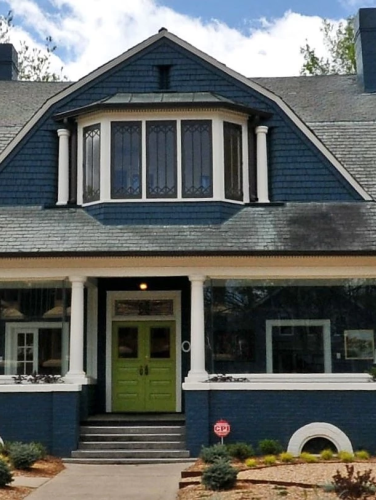
Willard R. Rogers House
(ca. 1902)
The highly regarded Charlotte architect once called this early Dutch Colonial Revival style structure home.
524 East Blvd, Charlotte, NC 28203
The modest but attractive East Boulevard home was constructed for longtime Charlotte architect Willard G. Rogers and his wife Eva Troy. Rogers likely designed the family home, now one of the earliest surviving examples of the Dutch Colonial Revival architectural style in Charlotte. The Dilworth house reflects the middle-class comfort typical of much of Charlotte’s first streetcar suburb, developed by the Charlotte Consolidated Construction Company (known locally as the 4 C’s) beginning in 1891.
Property Quick Links
A native of Cincinnati, Willard Rogers (1863-1947) followed his father (Solomon Willard Rogers) and grandfather (Isaiah Rogers) into the architect profession. The youngest Willard worked in his father’s firm and later Atlanta. Eva (1871-1942), also a Cincinnati native, was the daughter of the prominent Ohio River steamboat captain James Troy. She and Willard wed in 1892 and moved to Charlotte in 1900, where Willard was employed initially as an architect for Stewart W. Cramer (1868-1940), who at that time headed an engineering and contracting firm that built and supplied cotton mill machinery and equipment. Cramer later owned and operated the Cramerton Mills in Cramerton.
In 1905, Willard joined with Charles Christian Hook (1870-1938) to form the architectural firm of Hook & Rogers. In 1916, Willard established his own office and continued to design notable structures throughout the Piedmont, including the Catawba County Court House in Newton, the Haywood County Court House in Waynesville, Gastonia’s First Baptist Church, and a remodeling of the Charlotte Masonic Temple on South Tryon Street, as well as the Wilder Building, the Addison Apartments building, and the Southern Manufacturers Club in center city Charlotte. Willard also prepared plans for such notable homes as the Lemuel Harvey House in Lincolnton, the B. G. Thompson House in Greensboro, and the A. E. White House in Lumberton. As part of a 1937 Mecklenburg County school construction program funded in large part by the Federal Emergency Administration of Public Works, Rogers received commissions for the Davidson Colored School (now the Ada Jenkins Center), the Davidson School gymnasium, and a 12-room school building in Cornelius.
Mae King Blume purchased the Rogers House in 1940 and converted the residence into apartments. The widow of John H. Blume, Mrs. Blume purchased several Dilworth properties in the 1930s and 1940s, including the Walter Brem house at 211 East Boulevard, where she lived for many years. Indeed, during the 1930s, she was the proprietor of the Piedmont Hotel, the Queen City Hotel, the Frances Hotel, the Windsor Hotel, the Southern Hotel, and the Franklin Hotel, as well as the manager of the New Albert Hotel. The Rogers House was later sold in 1982 and restored to its former state as a private residence.

